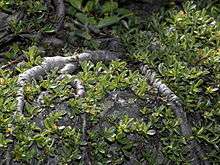Salix serpyllifolia
| Salix serpyllifolia | |
|---|---|
 | |
| Salix serpyllifolia at the Giardino Botanico Alpino Chanousia | |
| Scientific classification | |
| Kingdom: | Plantae |
| (unranked): | Angiosperms |
| (unranked): | Eudicots |
| (unranked): | Rosids |
| Order: | Malpighiales |
| Family: | Salicaceae |
| Genus: | Salix |
| Species: | S. serpyllifolia |
| Binomial name | |
| Salix serpyllifolia Scop. | |
| Synonyms | |
| |
Salix serpyllifolia is a species of flowering plant in the Salicaceae family.
Description
Salix serpyllifolia, also known as thyme-leaved willow, can reach a height of 10–30 millimetres (0.39–1.18 in) and a length of about 20 centimetres (7.9 in). This plant develop woody, dark brown, longitudinally striated, creeping stems. The leaves are tiny, simple, subsessile, spathulate to obovate, without stipules. The upper side is glabrous, glossy dark green covered with a thin waxy layer. Like all willows this species is dioecious. Catkins appear after the leaves. They are about 5 mm long, with yellow anthers. Flowers bloom from May to August.
Distribution
It is present in mountains of southern Europe, from the Iberian Peninsula, the Alps and the Balkans.
Habitat
This species can be found in stony alpine turf, rock crevices and screes at elevation of 1,700–3,200 metres (5,600–10,500 ft) above sea level.
Uses
Salix serpyllifolia contains salicin, the source of salicylic acid in aspirin.
References
- Pignatti S. - Flora d'Italia (3 vol.) - Edagricole – 1982
External links
| Wikimedia Commons has media related to Salix serpyllifolia. |